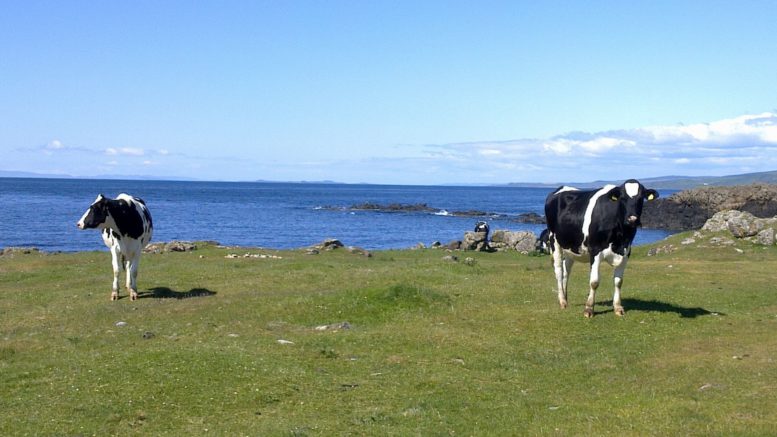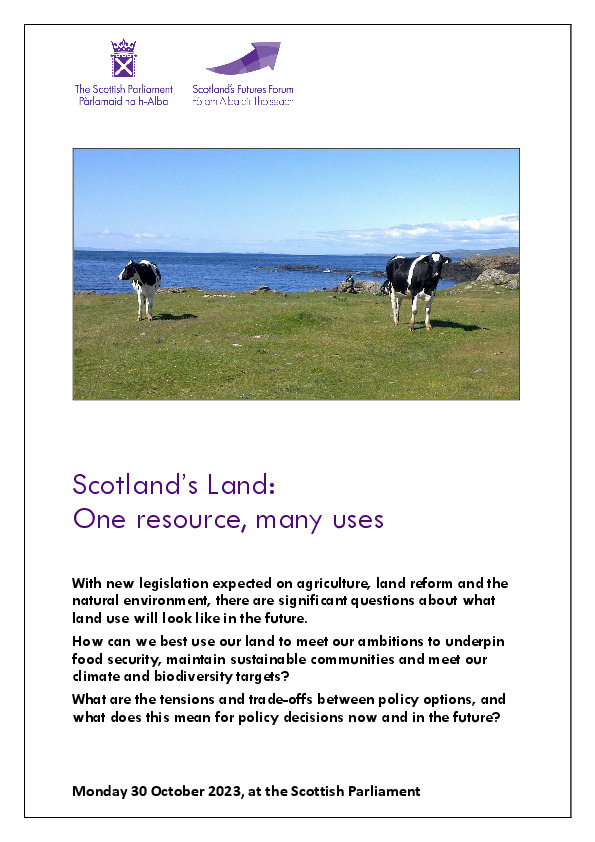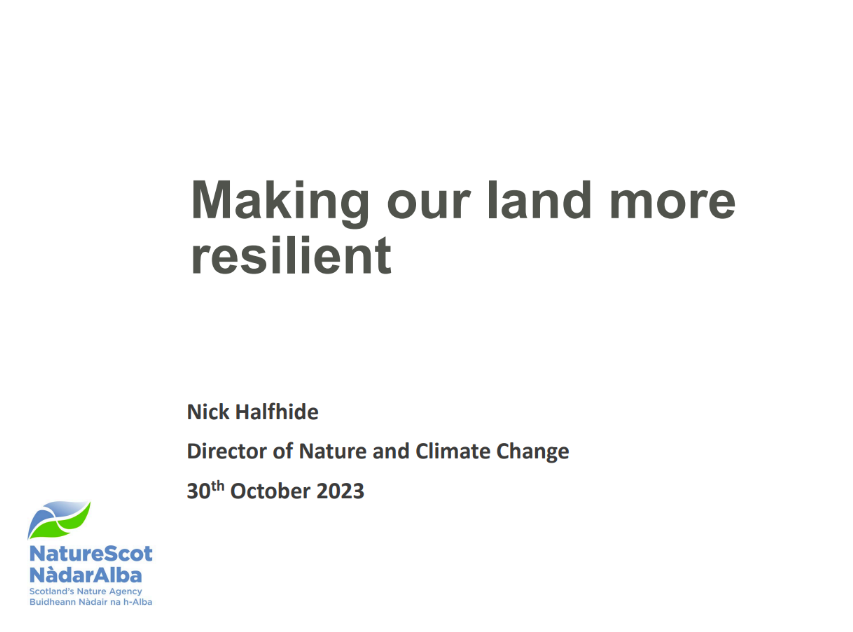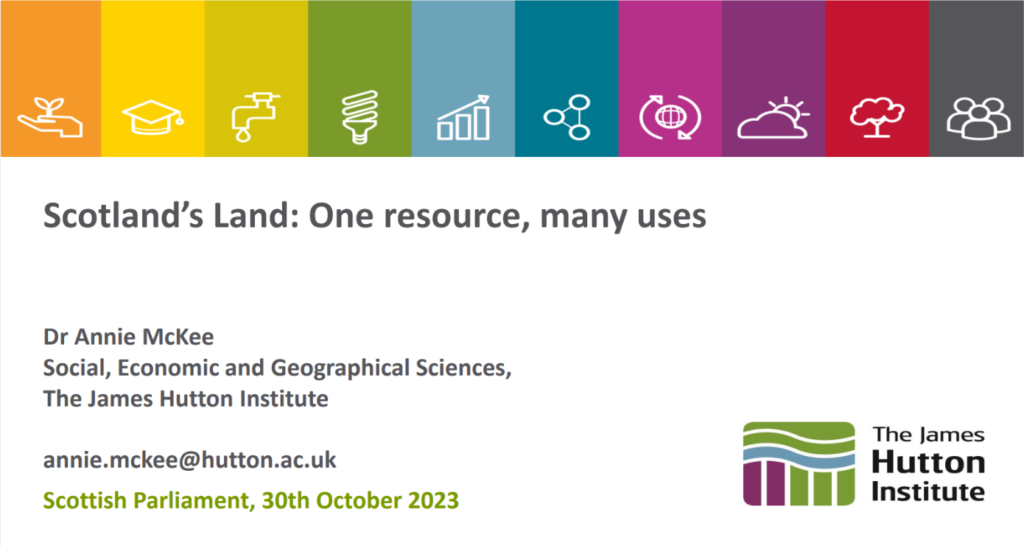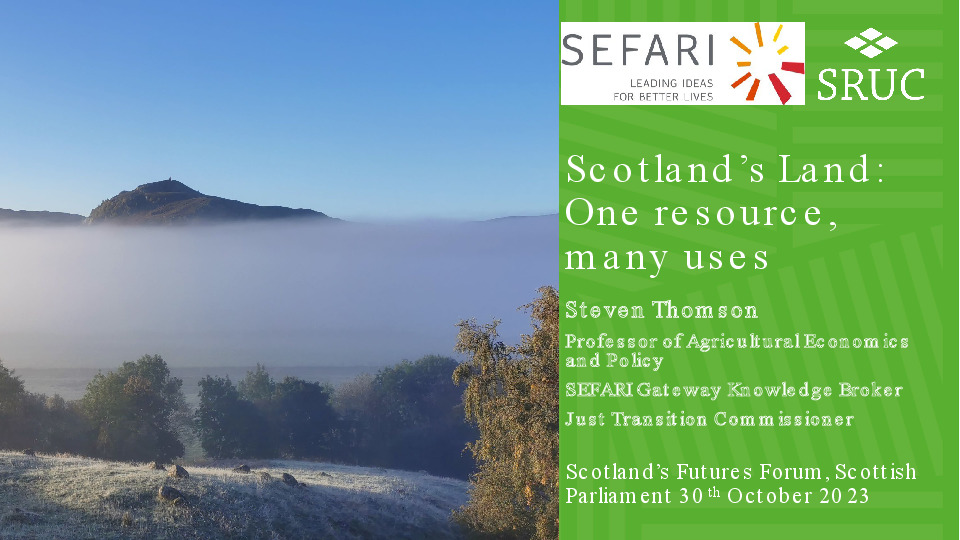Monday 30 October 2023, at the Scottish Parliament
With new legislation expected on agriculture, land reform and the natural environment, there are significant questions about what land use will look like in the future.
How can we best use our land to meet our ambitions to underpin food security, maintain sustainable communities and meet our climate and biodiversity targets?
What are the tensions and trade-offs between policy options, and what does this mean for policy decisions now and in the future?
Introduction
This event considered how we in Scotland can make best use of one of our most important resources: land
Chaired jointly by Edward Mountain MSP, convener of the Net Zero, Energy and Transport Committee and Finlay Carson MSP, convener of the Rural Affairs and Islands Committee, the event brought together a range of people with different perspectives and backgrounds to explore the opportunities, tensions and trade-offs in the policies available to us.
The event was opened with a series of presentations, looking at land use from differing perspectives, by:
- Nick Halfhide, Director of Nature & Climate Change at NatureScot
- Dr Annie McKee, Scotland’s Land Reform Futures project lead, social scientist at the James Hutton Institute and convener of Rural Housing Scotland
- Professor Steven Thomson, Professor in Agricultural Economics and Policy at SRUC
Following the presentations and Q&A discussion, event participants split into groups to explore the tensions, trade-offs and opportunities for the future in land use in Scotland.
This report presents summaries of the presentations and the key points that emerged from the workshop group discussions.
It also outlines the key questions for everyone involved in land use decisions to consider.
Report
Key questions
Vision
- What is our vision for the future of Scotland’s land? What information is available to support it? Who have we engaged in creating this vision?
- What are the priorities for high-demand areas? Where should peatland restoration, agriculture, forestry or energy be prioritised above other uses?
- What are the most important levers of power to make change? How can we empower communities to take and use those levers effectively?
Co-ordination
- What underpins all the policies and proposals, and how do we measure success?
- How are we ensuring that what we do fits with the vision for Scotland’s land?
Action
- How will we enable the scale of land-use change that is necessary to meet climate change and biodiversity targets in a just transition?
- How can we attract private investment for climate and/or biodiversity action while supporting the just transition?
- How can the rewards for taking climate and/or biodiversity action be shared appropriately?
Key messages
The following key messages emerged from the presentations and workshop groups.
The challenge we face
What we do at the moment will not sustain. Eitherwe decide to change to avoid further catastrophic environmental breakdown, or we will have to change while suffering the effects of catastrophic environmental breakdown. Both processes will be painful, but the first process gives us a chance to manage the pain.
Sustainability needs to be the overarching vision which makes everything else make sense. Without a sustainable environmental future, there will be no economic or social future. Land use should therefore be about long-term resilience and adaptation to climate and biodiversity change.
There are significant trade-offs between short-term gain in our current economic model and the medium and long-term benefits of moving to a more sustainable system. This is particularly true in the land use sector, where there may be short-term costs to transitioning to approaches that have a climate and biodiversity benefit and are resilient to longer-term pressures.
Lots of different people have an interest in how we use our land. This includes both communities of place and communities of interest, all of which will be diverse. Our debates and decisions also take place against the backdrop of an emotional relationship with land which can be as important as our economic relationship.
Scotland is caught in a wider global context where economic, social and environmental changes are significant and have a direct impact on our lives. We must consider the implications of geopolitics and international trade when taking our decisions.
What we can do
We have an opportunity to make significant change if we take the broader view. Land use is a complicated issue with a wide range of interests, opportunities and tensions. Given the legislation and statutory plans currently under consideration, Scotland can and should consider the wider implications of these changes together.
We need a robust process that includes information about today and ideas about tomorrow. We need a clearly understood plan and spatial representation of what we are trying to do with Scotland’s land, which we then base our actions on. This has to include our view of food security: what it means for people and land use.
We need to improve the data we currently keep and share. We need to know how much land we have and what happens on it now. There may be disagreement on whether land ownership or land use is more important, but we need transparency of who has power and control over decision making and who else is involved.
We need to anticipate the future and what that means for land use. We need to explore the effects of climate change on land use and, in light of that analysis, the options for how we use our land now and in the future.
We must allow for regional differences and flexibility for local decision making. Community empowerment means a loss of control for both the Government and the Parliament, but it can provide better outcomes and give influence to those who do not otherwise have a voice.
Presentations
Nick Halfhide, NatureScot
An overview of opportunities and challenges in improving Scotland’s natural environment over the coming decade
Vulnerable to climate chaos
As Nick emphasised, land is one of our key assets and a big player in the economy, sustaining many individuals, businesses and communities, with Scotland’s natural capital valued at £206 billion. However, our land is a finite resource, and large parts of it are degraded.
In his presentation, Nick focused on how we could make our land more resilient. As he explained, the poor condition of much of our land is closely connected with the crisis in our natural world. While increasing climate chaos is a key driver of biodiversity loss, so too is the intensification of land management that has occurred over the past few decades.
Nick pointed out that, in general, land in bad condition not only contributes to climate change through significant greenhouse emissions—for example, from degraded peatland—but makes us far more vulnerable to extreme weather brought about by climate change.
Change is unavoidable
As Nick explained, our current land use and management approaches has tended to transform diverse, complex, rough-surface landscapes that hold water, into simpler, less diverse, smooth, and generally drier landscapes. This means that an increase in severe droughts will present a challenge. More homogeneous land is also vulnerable to pests, pathogens, diseases, floods and fires.
Nick stressed that we need to prepare for these climate changes now—they are unavoidable and are proving more problematic than expected even in temperate latitudes, with the next degree of global warming coming three times faster than the last.
Managing for resilience
As Nick set out, we have to change the assumptions behind our land use for the past hundred years or so, such as managing land for a single crop. He argued that we need an ambitious and risk-based approach to stewardship of our land, as that makes sound economic social and environmental sense—as he put it, there is no alternative.
Current practices have to change significantly to enable us to achieve our net zero targets and to build resilience to climate change. He outlined a few key requirements in that regard:
- Manage land for resilience. Investing in our land to make it stronger and more reliably productive would leave us better able to cope with extreme events such as flooding and drought.
- Move to a biological circular economy. We need a far more regenerative form of agriculture and better links with nature, and farm and forestry support have to be strongly linked to associated outcomes to build a resilient rural economy.
- Learn from and scale up regenerative practices. Such practices build resilience into the system and cope better with climate extremes, giving more stable and predictable yields over time. Applying regenerative practices in all settings, not just farmland—for example, in peatland restoration, and in towns and cities.
Challenges and choices
Nick highlighted significant challenges and choices in four areas:
- Bioenergy—how much land should be used for that, and how should we do it?
- Food security—what does it really mean?
- Housing and workers—in some parts of the country, housing is the biggest constraint.
- Finance—how could we increase landowners’ access to private finance to enable them to make their land more resilient?
“We know how to do this”
Finally, Nick suggested that, while there are challenging times ahead for which we are not well prepared, there is also a vision of hope. Although climate change is unavoidable, we could make our land more resilient and enable its natural processes to function better.
As Nick put it, we know how to do this—we did it in the past, during wartime. We just need to get on with it and ensure that change is quicker and more extensive.
Dr Annie McKee, James Hutton Institute and Rural Housing Scotland
Exploring the key issues in relation to land reform and communities
Annie outlined the key challenges and tensions facing policymakers, especially regarding new legislation. To begin, she highlighted a key question: how does our system of land tenure in Scotland support or inhibit the goals that we need to meet?
She defined land tenure as the terms and conditions on which land is held, used and transacted within a particular system of rights and institutions that govern access to and the use of land. As she emphasised, it is about not just laws, but our social understanding of land.
As such, there are three key challenges in respect of Scottish land tenure:
- There is a lack of transparency and accountability in how land is owned and managed, with a lack of access to integrated, publicly accessible land data. Land management is often not transparent. Mandating the publication of land management plans for large-scale land holdings is a key proposal in the consultation on a new land reform bill. As Annie pointed out, transparency is the cornerstone of good community engagement.
- The increasing scale and concentration of private land ownership, and rising land prices in many areas, are undermining the goal of diverse land ownership in Scotland, as new entrant farmers and community organisations are priced out of land access.
- Power and inequality remain key characteristics of our land system, making it difficult to achieve a just transition.
Tensions and trade-offs
Annie moved on to summarise the areas that would potentially be addressed in the upcoming land reform bill.
The Scottish Government consultation proposed new duties on classified large-scale land holdings, including a legal duty on owners to comply with the Scottish Land Rights and Responsibilities Statement, along with a public interest test for the sale and purchase of large land holdings and pre-sale notifications for communities.
As Annie stated, there are tensions and trade-offs involved in policy making, especially where land reform policy might contradict with other Scottish Government policies and targets. She highlighted that there are outstanding questions around the scale of land ownership—for example, what did we mean by ‘large scale’?
In addition, she argued that the current fiscal context in terms of markets and Government support is challenging the objectives of Scottish land reform, in particular diversity of ownership
Lessons to learn?
Annie highlighted the New Zealand Government’s emissions trading scheme as an example of the complexities of seeking to achieve a just transition.
As she described, the scheme helped to contribute to a large-scale shift in land use to forestry, with some negative impacts on farming and rural communities. It is now under review, and considerable efforts have gone into working in partnership with farming organisations and communities. Annie identified that there may be lessons to learn from New Zealand’s experience.
Looking beyond land ownership
Annie emphasised the need to consider how best we use our land to achieve our ambitions: underpinning food security, maintaining sustainable communities and meeting our climate and biodiversity targets, along with the need to shift to a wellbeing economy, ensuring a just transition and overcoming social and economic inequalities.
As she noted, it is important that we develop land use plans according to the risks and opportunities facing Scotland. In particular, we need to look at how land tenure interacts with the risks—for example, are short-term agricultural leases undermining efforts to increase soil carbon?
Annie argued that we needed to look beyond land ownership to achieve these ambitions, and consider what new models of land governance may be necessary. As she highlighted, there is a lot to learn from other countries. She also stressed the need for Government intervention in the land market—for example, through the community land accelerator, which is currently under development.
Rights and responsibilities
Annie asserted that we need more democratic processes for land use decision making, with meaningful community engagement and representation, an on-going culture of dialogue, and efforts to dissolve historical hierarchies. She noted that the forthcoming land reform bill would hopefully promote and support innovations in that regard.
She also argued that we need a cultural shift in how landowners and land managers consider their rights and responsibilities around land—for instance, to promote human flourishing.
A tricky balance
In conclusion, Annie argued that we need to have a more open conversation nationally and locally about our land use vision. How would we reconcile what might be in the national interest—for example, woodland expansion—with what is sustainable at a local level, such as sustaining land-based employment?
How would the needs and ambitions of rural communities align with the goals of those who own and control the land resource? As Annie pointed out, there is a tricky balance to be struck between maintaining and enhancing public and private interests in land.
Professor Steven Thomson, SRUC
A summary of the outlook for Scotland’s agricultural sector and rural economy
“A cloud of uncertainty”
Steven described land managers as feeling lost in a cloud of uncertainty regarding Government policy, future climate challenges and their economic contribution to communities.
In considering those issues, he stressed the importance of first recognising what Scotland’s land mass comprises. He acknowledged that land reform is different for different people, and that an open and honest discussion is needed in that regard. For example, who is going to manage the land without large-scale landowners?
As he pointed out, land values are increasing significantly, especially with the potential for corporate insetting from peatland restoration and biodiversity gain. If money comes in from outwith Scotland, is was that good or bad? As he noted, we need to seriously consider the impacts that may result from that type of land ownership.
Steven argued that, while we often talk about targets for nature or carbon reduction, we hear less about the current economic contribution of land. As he explained, the benefits of land do not accrue only to the landowner or land manager; access to land benefits people, for example, and there is a tourism benefit from our landscape.
“Nobody seems to care about them”
Steven emphasised that land use is closely connected both upstream to its supply chain and downstream to processors and food manufacturers and retailers. As such, he argued, it is important to consider the economic consequences of change for the associated industries in our transition to net zero—as he put it, nobody seems to care about them.
Steven stressed that land is multifunctional—as the latestScottish Land & Estates report highlights, there are many different activities to maximise economic and environmental benefits from estates. He emphasised the need to consider the impact on small remote communities of policies involving changes to grouse moors or the role of gamekeepers.
He raised a key question: how do we support people in whatever land use transitions that we are seeking? He referred to what he described as huge resistance from the agriculture sector to woodland expansion, given the squeeze on the middle ground: the grassland where a lot of livestock are farmed to produce meat.
Green-on-green trade-offs
Steven set out the interesting economics of the monetary flows to the agricultural sector and associated industries, noting the important role of the renewable energy sector in land use just now.
He flagged up the need to better understand green-on-green issues and trade-offs, with examples such as part-year restrictions around ground-nesting birds preventing full-time jobs in peatland restoration.
In addition, Steven highlighted the issue of crofters’ rights, and contended that our agricultural policy system needs to recompense them for any changes that they have to make in order to meet the peatland restoration objectives.
On biodiversity, he noted that we need to better understand how we drove biodiversity enhancement, and he emphasised the need to really think through our targets, especially regarding species.
Joined-up legislation and policy coherence
Steven explored the need for policy coherence, highlighting potential interactions between current legislation and plans—for example, between the cross-compliance element of the proposed land reform bill and the Agricultural and Rural Communities (Scotland) Bill and its potential secondary legislation.
As Steven emphasised, when it comes to land, we need to start joining up our legislation better. On the same theme, he highlighted a real opportunity to embed the ambition and targets in the proposed Natural Environment Bill, in the Agricultural and Rural Communities Bill or in secondary legislation—for example, through a ‘farming for nature’ ambition.
“We need honest discussions”
Steven stressed that we need honest discussions about what is required to meet emission reductions targets for agriculture. As he argued, we have to keep in mind the justice element of the just transition. He noted that, while we often saw grand ambitions and bold statements, there is no transition pathway, or the pathways are unrealistic.
As he pointed out, driving change requires either regulating or incentivising it. For incentivisation, however, budgets are limited and sit within certain areas, mainly agriculture and forestry. As Steven put it, “Are we going to be bold enough to change those distributions? Probably not.”
Turning to Scotland’s updated climate change plan, he stressed the need to consider the global versus local issue in order to avoid perverse incentives, and the need to look at what is happening with scope 3 carbon emissions reporting. As he described, policy needs to catch up with that fast-moving area, as the current approach to reporting could present risks to farmers.
Finally, Steven highlighted a couple of key issues arising from the Scottish Government’s forthcoming land reform bill. On its proposed new public interest test, he raised a question: which public? As he pointed out, we have to think about how we apply a collective public interest test in understanding what is best for our land.
“Can we make it simpler?”
As Steven pointed out, we currently have the Land Rights and Responsibilities Statement; the agriculture bill includes a provision for a code of practice on sustainable and regenerative agriculture; and the proposed new land reform bill would introduce further statutory codes of practice.
He questioned whether a collective approach combining those things would be simpler. In particular, he highlighted the proposed natural environment bill as a huge opportunity to link up with the agriculture bill and transform agriculture for the future.
Steven concluded that the status quo no longer had any status. Things have changed, and things are changing. We need to change our approach if we want to derive the desired outcomes from our land in the future.
Q&A Discussion
A short open Q&A discussion followed the presentations, with participants considering themes such as biodiversity and resilience, the need for regulation and the question of what it might mean to be more radical on land reform in practice.
Resilience requires diversity
As was pointed out, there has been a huge increase in land prices in Scotland, with land being bought up by investors rather than farmers or new entrants. It was suggested that, while radical change ws needed, the horse may have bolted; participants noted that radical policies took time to bed in and could not be undertaken quickly.
Although there was plenty of legislation coming forward, as the presenters outlined, it was argued that, as yet, no clear pathways, let alone policies, had been identified for radical change. A question was raised: how would the various pieces of legislation deliver radical land reform on a timescale that addresses climate change and biodiversity loss as well as ensuring food security?
It was asserted that if we wanted to be bold, we needed to address two issues: capital gains tax rollover relief and the question of who was allowed to own land. It was argued that real radical change would involve looking at fiscal policies.
The capital gains tax rollover relief was currently a major issue, as it played a big role in land value inflation in Scotland. It was also suggested that unless we restricted land ownership, practices such as corporate insetting and associated price inflation would continue. That could be done in a variety of ways, such as restrictions on corporations owning land. It was noted that other countries set tests and restrictions for who owned land, and it was argued that everyone came to Scotland to buy land because we did not impose such restrictions.
On the theme of radical reform, comments were made on biodiversity. It was argued that resilience to biodiversity impacts driven by climate change, and resilience to the climate itself, rested on fairly diverse landscapes, and that monocultures were the last thing we want for our land. It was suggested that, when it comes to landscape, we needed to hedge our bets for greater resilience.
A valuable national asset
On the role of regulation and legislation, it was noted that, as with any national asset, the state needed to make it clear to owners what they had to do, together with penalties for non-compliance and rewards for positive behaviour. Land as an asset was too valuable to be left to an unregulated market.
However, it could be tricky to tweak land regulation sufficiently and take a radical approach, as there was a risk of throwing the baby out with the bathwater.
It was suggested that, given the timescale involved and the need to be radical, the Scottish Government’s principles for natural capital investment should be put on a statutory footing. A concern was raised that the legislation contained too many ‘shoulds’ in relation to community, biodiversity, land rights and responsibilities, and no ‘musts’.
The forthcoming land reform bill was identified as a huge opportunity to address that, but a lot of work would be required in a very short time to nail down what the principles would mean in practice and what people were being asked to do.
Community empowerment: a whole-population issue
Participants discussed how power differentials affected communities regarding land issues, and how we could empower communities. It was argued that we needed to integrate a vision for the people of Scotland, and participants considered how we ensured that policy always kept the reality of people and place in Scotland foremost in mind.
It was pointed out that recent research had shown that there was considerable public interest in land reform. When people were informed, they could participate and inform policy makers to make better decisions.
It was also noted that, while people often thought of land use as a rural question, it was actually a whole-population issue that brought different populations together.
Workshop groups: Tensions, trade-offs and opportunities
Following the presentations and Q&A discussion, event participants split into groups to explore the issues in more detail.
The workshop groups reflected on the tensions, trade-offs and opportunities for the future in land use in Scotland. The structure was based on the Scottish Parliament’s Sustainable Development Impact Assessment tool, which supports people to consider how decision-making will affect the sustainability of a society’s development.
Participants were also asked to consider the key questions that the Scottish Parliament should be asking the Scottish Government and other stakeholders during its consideration of forthcoming plans and legislation.
The following key points came out in the groups and post-event survey.
We face a complex and challenge future
Scotland is caught in a wider global context where economic, social, environmental changes are significant and have a direct impact on our lives.
With our compound social and economic linkages and multipliers, we are being swallowed up by forces that do not understand and probably do not care much about our communities of real people in real places.
Because of this, our decisions must be taken in global context. We must be wary of simply importing carbon in the form of meat, soft fruit or vegetables. For example, if we reduce beef production in Scotland, and end up importing more beef in the absence of dietary changes, will that see increases elsewhere that have a greater environment impact?
Any consideration of what to do domestically needs to include the wider implications of international trade on our climate and biodiversity obligations. With our current approach to land ownership, will Scotland continue to be a place where “global corporate interests can wipe their carbon karma”?
In this context, sustainability needs to be the overarching vision which makes everything else make sense. The way we use our land must support our efforts to tackle climate change and biodiversity loss and support human communities to live in partnership with animals and plants.
What we’re doing at the moment will not sustain: put simply, we cannot continue to live in the way we are living.
Either we decide to change to avoid further catastrophic environmental breakdown, or we will have to change while suffering the effects of catastrophic environmental breakdown. This applies as much to how we use our land as anything else: everything we do depends on stable nature and climate, but much of what we are doing depletes nature and affects our climate.
There is a huge tension in the pace of change needed to respond and the need to ensure coherent and effective policies. Time is needed to find thoughtful and coherent solutions, but do the processes in place, in government and in parliament, allow for both pace and policy coherence? Democratic engagement is essential, but it takes time.
Land use should be about long-term resilience and adaptation to climate and biodiversity change.
This will involve changes to the land, communities and landscapes we live in, which are dear to our hearts. The Scottish Government already intervenes in land use through funding decisions and regulations. Further change will involve radical decisions and decision makers being able to hold their nerve on difficult decisions. For example, could they introduce a land value tax on private land and use proceeds to support a Scottish land fund for community buyouts? Whatever the decisions, cross-party political leadership will be needed to ensure the long-term sustainability of our land use.
With the work taking place at the moment, we have an opportunity to make significant change. The various pieces of legislation and statutory plans mean that we can align targets across industries and sectors, and produce a cohesive approach to the use of our land for the future. There is also a chance to improve the health and wellbeing of the people of Scotland, with a focus using our land to produce on sustainable and affordable energy, heating and food.
In tackling these issues, we need to remember our role as custodians of Scotland’s land.
Those working on and with the land – in whatever way they do – will have deep emotional ties to it. Our debates and decisions take place against the backdrop of this relationship and our cultural inheritance, which is as important as our economic inheritance. What we believe our land is for will influence how we think it should be used.
However, we are only short-term inhabitants of Scotland. We are only here as individuals on average for 80 years or so. Our job is to leave the place in a better state than we found it, and this currently means making our use of it, and our lives on it, sustainable for the future.
How to approach the future
We need a robust process to take these decisions.
Land useis a complicated issue with a wide range of interests, opportunities and tensions. The way in which people in Scotland take – and will be taking – decisions on how we use our land over the coming months will be hugely important for the future.
To support that, we need a clearly understood plan for how we intend to use our land, which we then base our actions on. The status quo is a very long way from sustainability and there’s currently no route map to achieving a sustainable Scotland.
Any vision must allow for regional differences and flexibility for local decision making. A national picture does not mean all decisions are taken at a national level, but strategic direction will be required to balance biodiversity and climate change requirements with sustainable economic and social development.
As an example, a significant amount of Scotland is under crofting tenure, and it will need different policy approaches.
In developing the vision, we need to consider the sum of the various parts and look long term. The greatest tension is in how we use our land is that everything we do depends on nature, but much of what we do now harms nature.
We need a balance of strategic direction (top-down) and local flexibility (bottom-up). National and regional policies and targets can bring about change, but they can also create huge tensons and can lead to contradictions, such as tree planting on peat. Community empowerment means a loss of control for both the Government and the Parliament, but not everything should be decided in Edinburgh.
Robust decision making requires information about today and ideas about tomorrow.
We have no meaningful spatial representation of what we are trying to do with Scotland’s land. How much land do we actually have? Who owns and/or controls it? What happens on it now? What food do we produce and where? And, crucially, what are the different options for how we use our land now and in the future?
To support this, we need to need to improve the data we currently keep and share. We have some great data, including on catchment areas, but the land register is currently incomplete. Good data can help better spatial awareness, and open access to information is the foundation of transparency, accountability and innovation. We cannot innovate to deliver a sustainable Scotland if we do not know what we are working with.
We also need to anticipate the future and what that means for land use. We know that our environment will change significantly, with warmer temperatures and more extreme weather events. What work is going on to explore the effects of these changes on our current and potential future land uses? Can we set a baseline for domestic food production in that context?
Given these expected changes, we need to avoid mechanisms that lock us in to systems while we are still learning what the best systems are. We are not the only country facing these challenges, and we should aim to learn from best practice elsewhere. For example, Norway has systems often seen as superior as well as communities living in landscapes like Scotland. What can we learn from them?
Greater information will help support the better governance and meaningful collaboration that are required to meet the challenges of the future. Collaboration is needed among all stakeholders, particularly within policy making, so that we avoid divergent policies and practices that prioritise or incentivise contradictory actions.
Lots of different people have an interest in how we use our land. Bringing together different stakeholders and empowering them to take positive action will require significant work on the part of central and local government, but it is needed to bring about success.
For example, we cannot achieve our ambitions without private investment, but many private operators rely on public support. There are also lots of examples of engaged communities throughout Scotland doing things to improve the lives of those living there. Support for collaboration among the different groups is a key component of any sustainable future.
The governance approaches that will have the best long-term outcomes give a voice to those that do not otherwise have a voice. Arguably, for example, the interests of our environment and future generations are not explicitly protected in our system. Equally, there will be some losers as we move to a more sustainable future, and a properly Just Transition means that the poorest losers are supported.
What to consider about the future
There are significant tensions, trade-offs and opportunities in the use and management of our land in Scotland. When considering any proposed policy, legislation or change, it is vital to bear in mind the broader context of land use and the environmental, economic and social implications beyond the immediate aims.
What do we use our land for?
Perhaps the most obvious physical tension is in the priority and support given to the different major land uses in Scotland: forestry, agriculture, peatland protection and restoration, and renewable energy, especially windfarms. But these are not all.
Below are some areas for consideration and an outline of key points. In changing the use of land to meet our ambitions, questions will remain important regardless of the uses involved:
- What is the opportunity cost from choosing one policy over another, both in economic and environmental terms?
- What are the implications of changing land use beyond the immediate impact?
- What is the effect on the people involved? How do we compensate or incentivise people if we agree that their land should be used in a different way?
As well as providing food for consumption and export, agricultural production sustains communities through the supply chains. Policy changes that affect agriculture will impact on the lives and livelihoods of the people involved in the distribution networks and other related infrastructure.
Likewise, forestry has a wide range of impacts. The current focus can be on climate change and the carbon impact, but timber security is important given its use in construction.
There are clear trade-offs associated with the food systems, with domestic consumption and international trade both affected by what we grow and our relationship with food. It is worth being clear about what we mean by food security, especially given the food poverty experienced in Scotland.
Water infrastructurewill beunder greater pressure, with storage more important to respond to higher water use in hotter months, and drainage able to cope with increased concentrations of rainfall and other extreme weather events. More broadly, the rewetting of peatlands and the impact of planting or grazing on the water table will have significant effects on the ability of areas to cope with flooding and landslides.
Theexpansion of onshore and offshore wind energy will have significant impacts on local communities. It will require intervention to clawback money for those communities from the companies, which are often multinational, that are profiting from the facilities.
Housing is a major barrier to the development of sustainable economic opportunities and the communities around them. Given that little seems to have changed for the better in the past 25 years, a bolder approach is required, including interventions to encourage and enable people to stay in their local communities. As the Government itself notes, the right of people to enjoy their property peacefully is a central human right, but it is not absolute, as long as any intervention is proportionate and in the public interest.
How can we balance the short term and the long-term effects?
A significant trade-off is between short-term gain in our current economic model and the medium and long-term benefits of moving to a more sustainable system. For example, extractive industries like oil and gas are economically valuable to Scotland, with tax revenues helping to pay for public services, but they contribute to climate change that will cause significant harm now and in the future.
This is equally true in the land use sector, where there may be short-term costs to transitioning to approaches that have a climate and biodiversity benefit and are resilient to longer-term pressures. However, given “the status quo has no status”, change is coming. The most successful businesses embrace the long-term. Can Scotland do that, even when the decisions are hard or unpopular?
Land ownership v land use?
There are many people with different roles in the use of land: farmers, crofters, foresters and others. Some are landowners, and some are not. How important is land ownership, especially compared to land management and land use?
Local circumstances may dictate the answer to that question, but in every case it is important to have transparency of who has power and control over decision making and who else is involved, as well as who benefits.
The role of communities
Communities need to have a voice to be empowered and to be an active part of the process. There may be a sense of powerlessness, especially as rural communities are being asked to make a lot of rapid change. How can they be supported through that?
This includes communities of interest as well as communities of place. Both can be difficult to define – there are lots of nuances within communities – and there can be significant tensions between their views. For physical communities, critical mass is important for sustainability, particularly in rural communities. Proper place-making includes building the capacity of schools, emergency services and amenities, not just meeting house-building targets.
Questions for the future – for us all
These are questions that the Parliament could consider asking of both the Scottish Government and other stakeholders.
Vision
- What is our vision for the future of Scotland’s land? What analysis, information and data are available to support it? Who have we engaged in creating this vision?
- What are the priorities for the high-demand areas in which different land uses compete? For example, where should peatland restoration, agriculture, forestry or energy be prioritised above the other uses?
- What are the most important levers of power to make change? How can we empower communities to take and use those levers effectively?
Co-ordination
- What underpins all the current bills and policies, and how do we measure success?
- What tensions and trade-offs are there in the proposed policies and legislation?
- How are we ensuring that what we do fits with the overall vision for Scotland’s land? How are those who are working on separate bills, policies and actions co-ordinating their work?
- Do we need all the pieces of legislation? How do they link with each other? As well as the bills mentioned in the introduction, the Scottish Government has proposals for a Good Food Nation Bill, Circular Economy Bill and Human Rights Bill, which are all relevant to the use of land.
Action
- How will we enable the scale of land-use change that is necessary to meet climate change targets in a just transition?
- How can we attract private investment for climate and/or biodiversity action while supporting the just transition?
- How can the rewards for taking climate and/or biodiversity action be directed to and shared appropriately between landowner, tenant/crofter, communities and investors?
- How we ensure that the urban and commercial beneficiaries of land-management that favours climate and/or biodiversity action provide a suitable contribution, so that all the costs do not fall on rural land?
Speaker Biographies

Nick Halfhide leads NatureScot’s drive to reverse the current decline in nature, reduce greenhouse gas emissions from our land and sea, and help nature adapt to our changing climate.
He is working to protect 30% of Scotland’s land and sea by 2030, restore habitats and species across Scotland, and increase the way society values nature and all the benefits it supplies.
Nick has 30 years’ experience of working with nature in Scotland. As well as working for NatureScot for over a decade, he has held posts in the Cairngorms National Park Authority, the Deer Commission for Scotland, and South of Scotland Enterprise.

Dr Annie McKee is a senior social scientist from the James Hutton Institute, based in Aberdeen. She is a rural geographer with research interests that focus on landownership, land reform, community empowerment, and achieving sustainable development in rural areas.
Annie leads the Land Reform Futures project, which contributes to the Scottish Government’s Strategic Research Programme 2022-2027, and is currently leading a Hutton team exploring the social and economic impacts of ‘green’ land investment in rural Scotland.
Out-with academia, Annie is currently the voluntary convenor of Rural Housing Scotland, and an active member of the community where she lives in rural Aberdeenshire.

Professor Steven Thomson is a Professor in Agricultural Economics and Policy with 30 years of applied agricultural policy analysis and rural development research. Steven is heavily involved in supporting the Scottish Government design future fit agricultural policy and build on the principles of conditional direct support.
Steven also works with a wide range of stakeholders (including Scotland’s Farm Advisory Service), consultants, farmers, crofters and land managers on a wide range of agricultural, land use, land reform and communities policy issues through his SEFARI Gateway knowledge broker role.
Steven is currently the lead for the Rural Futures theme within the Scottish Government’s Strategic Research Programme 2022-2027 where he leads research on Rural Economies within SRUC and contributes to additional projects on: Land Reform; Improving Agricultural Practice; and socio-economic and greenhouse gas impacts from land use.
Attendance list
| Name | Surname | Company |
| Alasdair | Allan MSP | Rural Affairs and Islands Committee |
| Douglas | Bell | Scottish Tenant Farmers Association |
| Ariane | Burgess MSP | Rural Affairs and Islands Committee |
| Esther | Cabanillas Rico | Scottish Water |
| Finlay | Carson MSP | Rural Affairs and Islands Committee |
| Kaley | Cochran | Office of Brian Whittle MSP |
| Brian | Connolly | Scottish Enterprise / WeAll Scotland |
| Douglas | Cowan | Highlands and Islands Enterprise |
| Josh | Doble | Community Land Scotland |
| Adrian | Dolby | Buccleuch |
| Nicky | Downing | National Trust for Scotland |
| Jackie | Dunbar MSP | Net Zero, Energy and Transport Committee |
| Jamie | Fry | Zero Waste Scotland |
| Sarah | Govan | ClimateXChange |
| Nick | Halfhide | NatureScot |
| Virginia | Harden | Scottish Forestry |
| Emma | Harper MSP | MSP |
| Pete | Higgins | University of Edinburgh |
| Jon | Hollingdale | Scottish Community Alliance |
| Celeste | Kellock | University of Stirling |
| Nick | Kempe | Parkswatch Scotland blog |
| Robbie | Kernahan | NatureScot |
| Andy | Kinnaird | Scottish Government |
| Kenneth | Loades | SEFARI Gateway / James Hutton Institute |
| Deborah | Long | Just Transition Commission |
| Jennie | Macdiarmid | University of Aberdeen |
| James | MacKessack-Leitch | Scottish Land Commission |
| Calum | MacLeod | – |
| Donald | MacSween | – |
| Linsey | Mason-McLean | Scottish Forestry |
| Davy | McCracken | SRUC: Scotland’s Rural College |
| Alastair | McIntosh | Author |
| Bob | McIntosh | Tenant Farming Commissioner |
| Annie | McKee | James Hutton Institute |
| Michelle | McWilliams | Rowett Institute |
| Beatrice | Morrice | NFUS |
| Dave | Morris | Portmoak Community Council |
| Edward | Mountain MSP | Net Zero, Energy and Transport Committee |
| Andrew | Moxey | Pareto Consulting |
| Jenny | Munro | RTPI Scotland |
| Francesca | Osowska | NatureScot |
| Annabel | Pidgeon | Scottish Federation of Housing Associations |
| Colin | Reid | University of Dundee |
| Jill | Robbie | University of Glasgow |
| Emily | Shields | Office of Edward Mountain MSP |
| Donna | Smith | Scottish Crofting Federation |
| Pat | Snowdon | Scottish Forestry |
| Geoff | Squire | James Hutton Institute, Dundee |
| Vicki | Swales | RSPB Scotland |
| Steven | Thomson | SRUC: Scotland’s Rural College |
| Charles | Warren | University of St Andrews |
| Michael | Weatherhead | Wellbeing Economy Alliance |
| Bruce | Wilson | Scottish Wildlife Trust |
| Stephen | Young | Scottish Land & Estates |
The event was supported by officials from the Scottish Parliament and Scotland’s Futures Forum.
Partners


